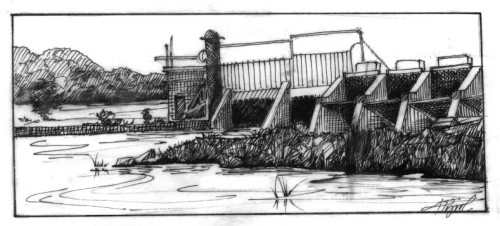
The water level in any river ebbs and flows depending on how much precipitation falls, and the inhabitants of the river readily adapt to these changes. But what happens to aquatic species when a hydroelectric dam disrupts the natural rhythm of a river? Nature can adjust to just about anything, but not without time. The changes in flows at hydroelectric dams happen in minutes and hours, not with the rhythm of the seasons.
Stretches of rivers below hydroelectric dams can be dry or flooded depending on whether or not the dam is generating electricity. The negative impacts of these dams are largely the result of this variability. High flows entice small fish and insect larvae to the margins of the river. A rapid drop in water level can strand them there. Low flows, on the other hand, crowd species together, increasing predation and competition for food sources. High flows flood or scour out preferred habitat while low flows with less turbulence prevent adequate mixing of oxygen and water.
Upstream from hydroelectric dams, rapid draw-downs of water can hurt the productive, shallow edge habitat of dam-formed lakes. These areas can be eroded if water levels drop too quickly. Fish are most affected by rapid fluctuations during their spring spawning time. High water levels in the reservoirs entice fish to spawn in the “new” shallows. Cool-water species like the smallmouth bass spawn in water depths of 18 to 36 inches. Water at these shallow depths is the first to warm to the preferred temperature range of 60 to 70 degrees Fahrenheit. Their eggs can take up to ten days to hatch, so dropping the water level suddenly during spawning can dewater the nests, killing the eggs.
All of these ecological factors have been carefully considered over the past few years on the Connecticut River. Three dams on the Connecticut – the Moore, the Comerford, and the McIndoes Falls – together are called the Fifteen Mile Falls hydroelectric project (FMF). The FMF is the largest hydro generating site in New England, directly affecting a 26-mile-long reach of the river. In July 2001, the operating license for the FMF dams expired. A cooperative effort among the dams’ owner, federal and state governments, and grassroots environmental organizations began in 1996 and resulted in a new license being issued in 2002.
How do environmental considerations become a part of a licensing discussion? Under our common law, all waters of the United States are considered a public trust resource. The state holds the water and the lands under the water in trust for use by all the people of the state. Individual use of the people’s waters, whether to install a dock or operate a hydroelectric dam, is by permission; it is not a right.
The new license for the FMF dams sets out standards for the protection of water quality, fisheries, wildlife, recreation, land use, and aesthetic and cultural resources. For example, the new FMF license requires that minimum flows be maintained in the river below each of the dams at all times. Minimum water flows reduce the negative impacts of hydroelectric dams by guaranteeing that the primary river channel always has water in it. At each successive dam downstream in the FMF project, minimum flows (measured in cubic feet per second) are successively higher, which reflects the increasing size of the Connecticut itself. The new FMF license also specifies time-of-year drawdown limits for the reservoirs above each dam to prevent the dewatering of fish nests.
These minimum flow and drawdown levels were not arbitrarily plucked out of the air. Scientific studies determined the minimum protection necessary for the aquatic habitat and the species that rely on that habitat. As a result, the needs of the aquatic species are now part of the equation for operating the FMF dams.
Rapid, repeated, and unnatural changes in the flow of a river pose threats to the ecological health of the river. But as scientists and river ecologists have learned more about how river flows affect river habitats, the operators of hydroelectric dams are discovering ways to generate electricity while doing far less harm to river ecosystems. The new license for the three FMF dams will restore much of the original rhythm to the upper reaches of the Connecticut. As a result, the fish, and the food chain they depend on, should be healthier over the next 40 years of the new license than they were over the previous 40 years. People, meanwhile, will still benefit from the renewable energy provided by the dams.

